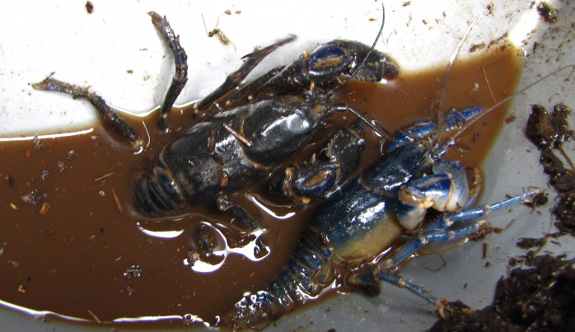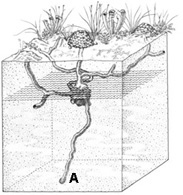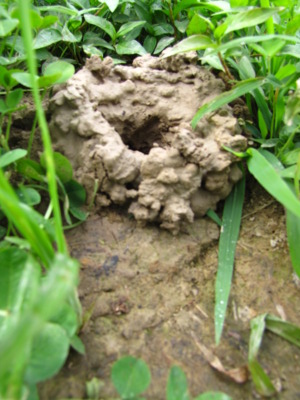
Crayfish in the garden

 Crawdads (known to most of
the world as crayfish) show up in the garden if the spot is already
troubled. Only our back garden, with its high groundwater and low
topsoil, shows signs of crawdads, but there the crustaceans can cause a
bit of trouble. They aren't actively eating my plants, but they
do send up new chimneys to excavate their underground burrows from time
to time, and the piles of mud tend to squash seedlings.
Crawdads (known to most of
the world as crayfish) show up in the garden if the spot is already
troubled. Only our back garden, with its high groundwater and low
topsoil, shows signs of crawdads, but there the crustaceans can cause a
bit of trouble. They aren't actively eating my plants, but they
do send up new chimneys to excavate their underground burrows from time
to time, and the piles of mud tend to squash seedlings.
I'm far from an expert at crayfish, but I once had a scientist identify
our brilliantly blue crayfish as Upland Burrowing Crayfish (Cambarus dubius). This
species is one of the few that spends nearly all of its time
underground (rather than living in a creek or pond), although the
crawdads do come out at night to eat decaying organic matter and
insects.
 The point of the burrow isn't
just protection from predators --- the caverns dip down into the
groundwater so that these crawdads can keep their gills wet enough to
breath even during droughts. This particular species builds
pretty big burrows, sometimes extending three feet into the earth and
with up to five entrances, and several crawdads can live in each
one. No wonder they kick up so much mud into my garden.
The point of the burrow isn't
just protection from predators --- the caverns dip down into the
groundwater so that these crawdads can keep their gills wet enough to
breath even during droughts. This particular species builds
pretty big burrows, sometimes extending three feet into the earth and
with up to five entrances, and several crawdads can live in each
one. No wonder they kick up so much mud into my garden.
I've been trying to find the positive side of crawdads in the garden
ever since I moved into their habitat. My first thought was that
the crustaceans should be good for chickens to eat, but our hens ran
away from the crawdads we caught for them. (Bradley suggested
that his cats won't eat the burrowing crawdads but do like the ones in
the creek, so I might try again with creek dwellers later.)
I've now decided to think of burrowing crawdads as dynamic
accumulators who are helping build the problematic back garden
soil. After all, they aerate the ground with their burrows and
haul organic matter down to improve the earth at lower levels.
I'll keep telling myself that every time the burrows slaughter a
vegetable seedling and maybe I won't get so angry.
Want more in-depth information? Browse through our books.
Or explore more posts by date or by subject.
About us: Anna Hess and Mark Hamilton spent over a decade living self-sufficiently in the mountains of Virginia before moving north to start over from scratch in the foothills of Ohio. They've experimented with permaculture, no-till gardening, trailersteading, home-based microbusinesses and much more, writing about their adventures in both blogs and books.
Want to be notified when new comments are posted on this page? Click on the RSS button after you add a comment to subscribe to the comment feed, or simply check the box beside "email replies to me" while writing your comment.

As Forest Gump would say... "Momma alway said, when life give you lemons... make gumbo!"
A little boiling water. Old Bay Seasoning (doubt you can get any real Cajan seasoning up there), potatos and a couple ear of corn. Now that is some sho'nuff good eatin.
What about turning it into a future summer pasture? Plant some willow trees. They grow quickly and love a watery soil. Sheep, goats and cows love the shade that a willow tree offers on a hot day. These animals will keep the willow trees trimed evenly from the ground. It is a beautiful site.
Another thing you might use it for is corn. Corn uses a lot of water and the crayfish might give it a fertil soil to plant it's toots in. Not sure of this.
MamaHomesterder and Tom --- The trouble with eating the crawdads (or even feeding them to chickens, actually) is that they're very inaccessible. They only come out at night or during heavy rains, and are otherwise safe underground. I read several gardening forums when researching crawdads in the garden and all of the people with burrowing crawdads report that catching them is not easy.
Daddy --- The sound is very odd. That's the other downside is if you lose precious topsoil down the crawdad hole!
Mona --- This is actually a very small area, not nearly big enough even to pasture a few chickens in. I've got a bit of sweet corn there now, but it doesn't like it much more than anything else does.
What we're doing with the area is building up the topsoil slowly but surely by adding lots of manure and letting it grow cover crops instead of vegetables as much as possible. The upside of the site is subirrigation! The beds that we've built high enough that they no longer drown plants' roots are actually pretty good growing area.
Former City Girl here! But we just built a house on semi-rural 2.65 acre plot w/ a 1/4 acre crawdad field adjacent to a 7 acre stock pond. (Yes, I plan on trapping and eating some of the crayfish-they make special traps for that.) But my comment is about what to GROW there. I have done some research (talking to locals) and they recommend growing sweet potatoes and melons there. Logic being that the abundant water appeals to those crops and the crops grow in a season where the water table will likely be lower. (Lower so the plants don't drown.) I, like you, don't want to see the land lay unused. Best of luck with yours.